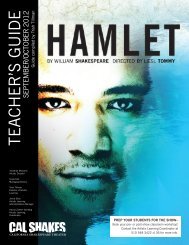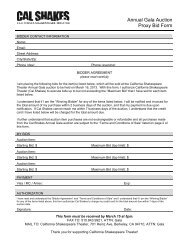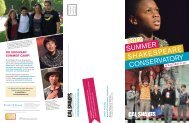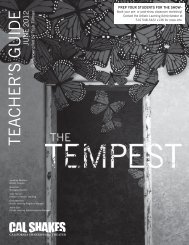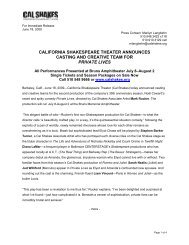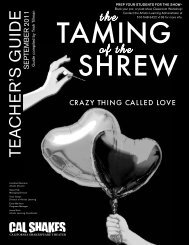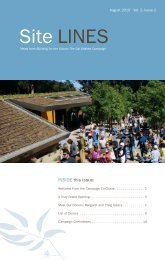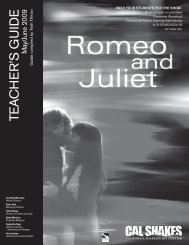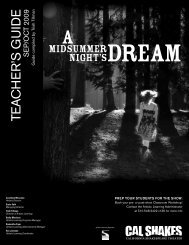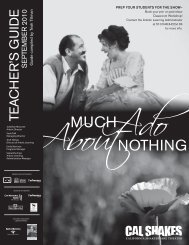Twelfth Night teacher's guide - California Shakespeare Theater
Twelfth Night teacher's guide - California Shakespeare Theater
Twelfth Night teacher's guide - California Shakespeare Theater
You also want an ePaper? Increase the reach of your titles
YUMPU automatically turns print PDFs into web optimized ePapers that Google loves.
Status One Through Ten (PAGE 1 of 2)<br />
Overview: This activity is a physical demonstration of status behaviors that people can adopt, and is useful for<br />
understanding the class system present in a stratified society such as <strong>Shakespeare</strong>’s England.<br />
Grade: 5-12<br />
Goal: Students will experience a kinesthetic understanding of the body language relevant to social status and transfer that<br />
knowledge to a discussion of the characters in <strong>Twelfth</strong> <strong>Night</strong>.<br />
State Standards: English Listening & Speaking Applications §1 & 2<br />
Outcomes: Students will be able to recognize status behaviors more clearly, relate them to the characters in the play and to<br />
modern social situations.<br />
Materials:<br />
Index cards labeled 1-10, or use playing cards 1-8, plus the Queen and King.<br />
If you have more than 10 students, use two or three of each number.<br />
Activity:<br />
“Status” is a specific way of defining a person’s position relative to others. It is useful for an actor to realize levels of status<br />
behaviors and recognize them in others; it is particularly useful for understanding <strong>Shakespeare</strong>, where the class that one<br />
was in was not a matter of choice, and specific behaviors were codified for members of higher or lower status to relate to<br />
each other. For instance, in Edwardian English households of the early 20th century, servants had to turn their faces to the<br />
wall whenever a member of the family that they served happened to pass by. Many people, servants or not, were not even<br />
allowed to look directly at the King of England at certain times in English history. Even today there is a strict protocol of<br />
behaviors one must observe while in the presence of Queen Elizabeth II.<br />
How to Play:<br />
Have the students simply walk all around the room, changing directions frequently.<br />
Describe certain behaviors of “high” and “low” status people, and have the students take on those behaviors.<br />
“High” status behaviors:<br />
Make direct eye contact and hold it<br />
Have a straight back<br />
Smooth controlled walking<br />
Lifted chin<br />
Calm expression<br />
Arms are relaxed at the sides<br />
“Low” status behaviors:<br />
Make eye contact very briefly and look away<br />
Slumped shoulders<br />
Hesitant walking<br />
Lowered chin<br />
Many facial expressions<br />
Arms are moving about, touching clothes or face or hair<br />
After the students have practiced the behaviors, you may want to process the feelings that came along with taking on these<br />
kinds of status. Focus on how you felt about others as well. Emphasize that status is simply one way of looking at human<br />
behavior.<br />
PAGE 37



